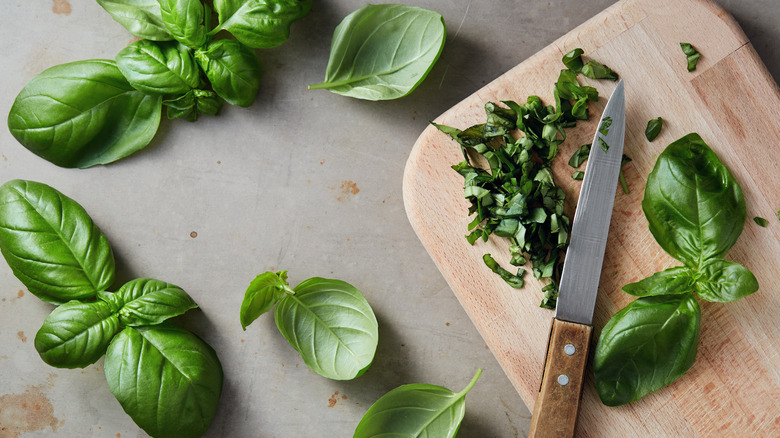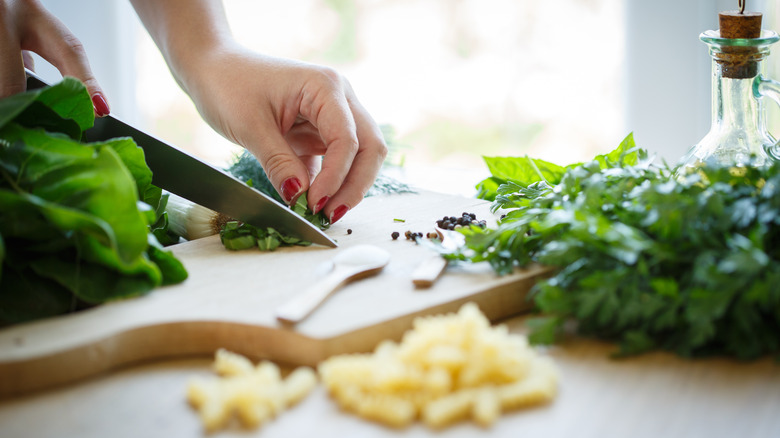Gordon Ramsay's Stacking Technique For Chopping Basil
Whether you have a potted plant or a bunch from the grocery store, fresh basil is one of the most versatile and fragrant herbs out there. It is a delicate herb, so you must handle it gently to avoid bruising, which can affect its taste. In short, don't butcher it by hacking your knife willy-nilly on the board. By doing that, you leave a lot of flavor on the board, making the herb taste metallic and wilted.
Michelin-starred chef and TV personality Gordon Ramsay has an incredible trick to cut fresh basil without bruising it. His hot tip: Roll your basil. In a video of tips on chopping different herbs, Ramsay suggests rolling your basil leaves like a cigar before slicing. This will ensure a uniform chop, delicately working your knife through many layers of basil. To begin, wash your herbs to remove any dirt, and then dry them on a paper towel. Wet herbs bruise easily, so drying them is ideal. Next, stack the leaves.
Stop, stack, and roll
Gordon Ramsay suggests stacking the basil leaves, placing the biggest leaf on the bottom, and layering smaller ones on top. Next, roll the stack of basil leaves into a tight cylinder. This makes it easier to chop multiple leaves at once. This technique is called a chiffonade — which is ideal for certain herbs like basil — and helps you create thin, ribbon-like strips.
To begin chopping, hold the rolled basil leaves firmly on the cutting board and make crosswise cuts with a sharp knife. Ramsay suggests protecting your fingers when cutting by tucking them in so only the first knuckles are exposed. Start from one end of the rolled basil leaves and work your way to the other. The result will be fine, evenly chopped basil.
Chopped basil is best when used immediately, as it can quickly lose its flavor and vibrant color. If you don't plan to use it right away, store it in an airtight container in the refrigerator, but keep in mind that its quality will decline over time. The same technique can be used on other leafy veggies and herbs like spinach, collard greens, and mint.
Why bruising is bad
This goes for any delicate herb: Don't bruise it. And it's easy to do. You can crease fresh herbs by simply bending them. According to a study published by Horticulturae, the cells in the leaves — which carry all the flavor compounds — rupture easily, releasing their flavor and aromatics.
Bruised basil leaves can also undergo color changes. The vibrant green color of fresh basil can turn darker or develop brown spots where the leaves have been damaged. Cut basil will also oxidize quickly. This not only affects the visual appeal of the herb, but it will also indicate an overall flavor that's just ... meh.
You want to keep the cells as intact as possible to flavor basil-based dishes like pesto pasta and tomato soup. The warm temperature in certain dishes also ruptures herb cells, this time releasing their flavor into the food. So, follow Gordon Ramsay's advice and roll your basil; it will protect your herb when you chop.


